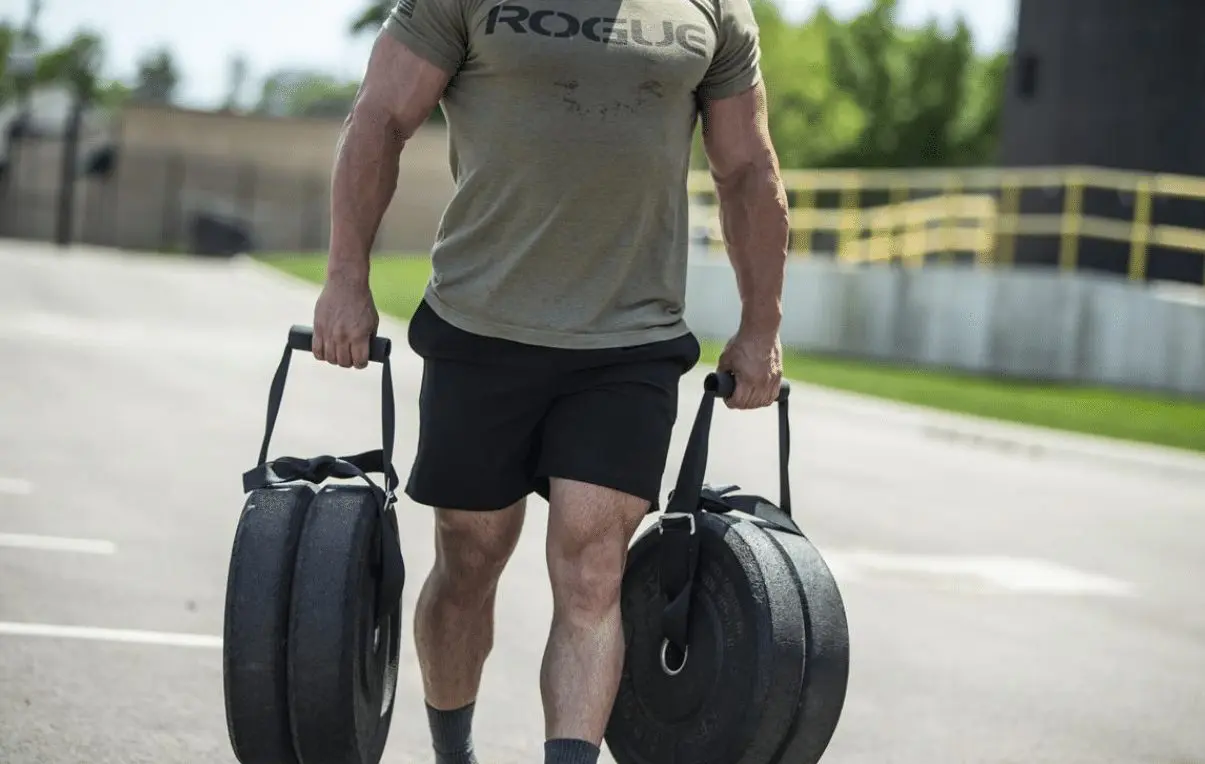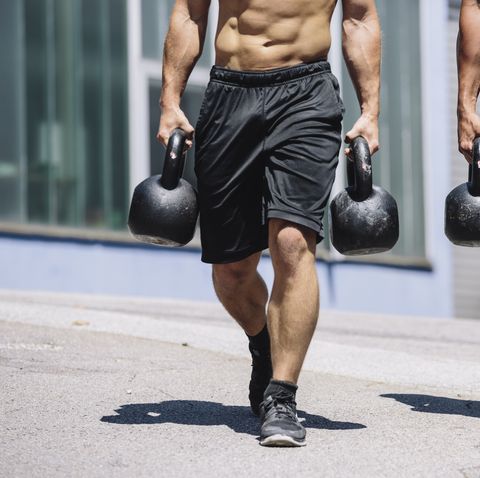
The best online fitness resource you'll ever need. We filter out the BS to ensure you meet your health and fitness goals!

The best online fitness resource you'll ever need. We filter out the BS to ensure you meet your health and fitness goals!

The farmer’s carry is one of the best exercises you could possibly incorporate into your training regime. It helps to build full body strength and endurance, promotes good posture, and elicits hypertrophy through the full trunk and torso. It is also suitable for complete beginners but can be scaled upwards to challenge even the most advanced lifters and athletes.
The farmer’s carry is also one of the simplest exercises going, with the most amount of carryover into real, everyday life and any kind of athleticism going.
It is essentially a loaded carry, in which you hold a weight in each hand, stand with a neutral spine, and walk for a set distance or amount of time. If you ever carry anything in your daily life, or if your torso ever comes under any pressure whatsoever, it will be useful to you – this is to say, it’s useful for near enough everybody!
There are few exercises that offer so much benefit from such a simple movement.
This simplicity is perhaps its first major benefit. You don’t need much prior training to be able to perform a farmer’s carry. Simply stoop down, pick up the weights as you would for a deadlift or similar posterior lift, stand up, walk with them, then drop them. Farmer’s carries will fit into any routine, either as a warm up, conditioning element, accessory movement, or even the focus of the session itself (try swapping your deadlift day for farmer’s carries and watch your lifts improve).
When you perform the farmer’s carry properly, it will challenge all of the major muscle groups in your body. Because so much muscle fibre is used under often quite intense loads, your heart rate will spike enormously. You will also build immense core and trunk strength as your body fights to remain stable under load.

The farmer’s carry will target both your upper and lower body, too. It will intensely work your biceps, triceps, forearms, shoulders, upper back, trapezius, quadriceps, hamstrings, calves, lower back, obliques, transverse abdominis, and rectus abdominis, for starters. If you go really heavy or intense, you may even feel other muscles jump in, like the pectorals.
There really aren’t many exercises that work this sheer mass of muscle in one go!
In practical terms, this will result in a stronger, more stable core, as mentioned above. It will also mark a tremendous improvement to your gripping strength, as your forearms, wrists, hands and biceps struggle to maintain a hold of the weight. This means a direct carryover into any exercises or sports that involve picking things up – deadlifts, rows and pull ups will all benefit, as will combat and grappling sports, Strongman events, and contact sports like Rugby or American football. Climbers will also benefit, as they see their grips improve.
Your posture will also benefit from the farmer’s carry. It will work your core and lower back together, promoting and strengthening good posture. Additionally, proper form will rely on you keeping your shoulder blades squeezed back and down, opening up your collarbone and chest, further helping to develop correct posture.
Anybody looking to either gain muscle, lose weight or improve conditioning will also do well to include farmer’s carries in their regular routines. The amount of muscle fibre used, in such an intense way, means that near enough full body hypertrophy will be elicited by any style of heavy carry. As mentioned above, this will cause your heartrate to spike enormously, both representing a great benefit to cardiovascular fitness and, crucially, taking you into the 85%+ heart rate Orange Zone, which will mean that your overall metabolism is boosted for hours after you finish training.
Finally, there is a lot to be said from simply showing your body what you expect of it. If you want to be able to lift big and heavy, you need to put your body under big, heavy loads, forcing and allowing it to adapt to them. Any exercise that puts your whole body under maximal loads will improve the skill of strength, showing your body how to maintain integrity under large forces. Notwithstanding the yoke walk, the farmer’s carry is perhaps the best example of this kind of exercise.
As long as you are carrying a heavy weight in each hand, with good posture, for a set duration, you can call it a farmer’s carry. With this in mind, you can use kettlebells, dumbbells or even plates to perform them.
However, it may be hard to find kettlebells, dumbbells and plates that are heavy enough to perform them properly – unless you are an absolute beginner or are going for longer distances, such as 500-yard walks.
For this reason, proper farmer’s carry handles are best. You can load them up with as much weight as you need, and they are well-balanced. If your gym doesn’t have a set (they are quite specialist outside of strength sports, so most commercial gyms won’t have any), a hex or trap bar will work perfectly well. You can stand in the middle, load them up with three or four plates on either side, and carry them easily enough. It won’t be quite as balanced as proper handles, but it will work very well and will force you to keep a slower pace.
Depending on your goals, you can set yourself either a target time or distance. Time may be more appropriate for conditioning at medium loads. Distance can also be used for this and will usually work best for strength work in the higher weight ranges.
For example, a heavy farmer’s carry may be 30 metres, sometimes even less. This will probably represent your main strength movement in any given session. On the other hand, if you’re going for endurance and/or conditioning, you could set yourself a quarter mile carry, or simply go as far as you can in ninety seconds.
Either way, to perform a farmer’s carry:
There are a few things to bear in mind to both keep your farmer’s carries at their most efficient and effective, and to keep yourself safe as you perform them. Make sure to take note – farmer’s carries can be the best exercise in your arsenal for building strength and muscle, so make sure you’re doing them right.

Weight selection is crucial with farmer’s carries. There are two exercises for which I would say a certain thing – if you don’t have enough weight, it isn’t the exercise. These are deadlifts and, of course, the farmer’s carry. If there isn’t enough weight on the bar, it isn’t a deadlift – the posterior chain will not be engaged the way it needs to be. If you don’t have enough weight in your hands, you’re not performing a farmer’s carry – you’re just walking around with a couple of weights.
So, don’t go too light. You should just about be able to make it the distance or time you’ve settled on. You should barely be able to hold onto them, you should be struggling to maintain correct posture, and your heart and lungs should be in rags.
However, begin light when you’re first starting out. Use a decent amount of weight, but if you cannot maintain decent posture, and if you’re struggling to hold onto the weights, bring it down. The first thing to go will probably be your grip – it will be undertrained compared to the other mechanisms being used. Allow it time to catch up.
Keep your muscles engaged. Don’t slump. You will want to, but don’t. This battle is where half the benefits come from, especially with regards core strength and control, and posture. Try not to lean forwards from the waist. Again, you will want to – you will want to fall forwards with the weights. Don’t. Remain upright and stable. Carry the weights, don’t fall behind them.
Also, don’t shrug. It will be a natural instinct to do so. Keep your shoulders neutral and your scapulae back and together. This will keep you stronger and will help you to maintain correct, safe posture. Doing anything else risks putting your spine out of alignment, which you really don’t want to be doing under such a heavy load.
Finally, breath. Holding your breath through a brace is not appropriate here – you will see stars and then hit the floor. Keep your breathing steady, linking it to your movements. Do everything slow and controlled and you will get the most out of your farmer’s carries.
There are plenty of different ways to perform a farmer’s carry, to make them harder or easier, to emphasise different aspects, or simply variety for its own sake, to keep things interesting.

There are plenty of variables at work, for starters. Distance and/or time travelled, weight used, rest times and so on. Change them up. If you want to make it harder on your cardiovascular system, and challenge your endurance, add 20 seconds or a few extra yards to your walk. If you want to make it more challenging on your strength, add weight for the same distance. Alternatively, consider not walking on a flat, smooth surface. Go cross country, go uphill, set up a gauntlet with slaloms, twists and turns.
Other than this, there are different forms of the carry.
To reduce the overall load but put more of it into your core and trunk, especially your obliques, try a suitcase carry. Simply have weight in one hand. Your torso will have to fight against it to remain upright.
Alternatively, use mismatched weights – go heavier in one hand than the other. You will face the same issue and your body will have to compensate in the same way, whilst increasing the overall weight you are having to move.
If you want to make it harder on your forearms, try using fat handles. This will make gripping it a lot harder.
If you want to be stronger, steadier, and bigger, there are certain compound movements you need in your routine. Enough attention is given to squats, deadlifts and presses. To truly challenge yourself, physically and mentally, and to really boost the amount of weight under which your body is able to labour, try carries. Try the farmer’s carry. Every other lift will improve.